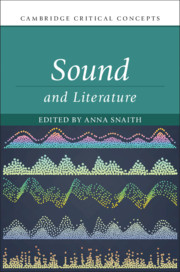Book contents
- Sound and Literature
- Cambridge Critical Concepts
- Sound and Literature
- Copyright page
- Epigraph
- Contents
- Figures
- Contributors
- Acknowledgements
- Introduction
- Part I Origins
- Part II Development
- Part III Applications
- Chapter 10 What We Talk about When We Talk about Talking Books
- Chapter 11 Prose Sense and Its Soundings
- Chapter 12 Dissonant Prosody
- Chapter 13 Deafness and Sound
- Chapter 14 Vibrations
- Chapter 15 Feminism and Sound
- Chapter 16 Wireless Imaginations
- Chapter 17 Attending to Theatre Sound Studies and Complicité’s The Encounter
- Chapter 18 Bob Dylan and Sound: A Tale of the Recording Era
- Bibliography
- Index
Chapter 15 - Feminism and Sound
from Part III - Applications
Published online by Cambridge University Press: 29 May 2020
- Sound and Literature
- Cambridge Critical Concepts
- Sound and Literature
- Copyright page
- Epigraph
- Contents
- Figures
- Contributors
- Acknowledgements
- Introduction
- Part I Origins
- Part II Development
- Part III Applications
- Chapter 10 What We Talk about When We Talk about Talking Books
- Chapter 11 Prose Sense and Its Soundings
- Chapter 12 Dissonant Prosody
- Chapter 13 Deafness and Sound
- Chapter 14 Vibrations
- Chapter 15 Feminism and Sound
- Chapter 16 Wireless Imaginations
- Chapter 17 Attending to Theatre Sound Studies and Complicité’s The Encounter
- Chapter 18 Bob Dylan and Sound: A Tale of the Recording Era
- Bibliography
- Index
Summary
Attuning to feminism with sound as a trans-historical listening practice, this chapter considers the intersections of feminism(s) and sound through echo, making the case for the phenomenon of echoic sound as feminist method alongside considering Echo, the Greek mythological character whose reappearances through literature confer upon her a cumulative agency, evidenced in her sonic invention/intervention. The writing charts a reading of Echo as complicating any idea of a coherent female identity, and then considers echo’s legacy through two recent examples of sonic art works: Bouchra Ouizguen’s Corbeaux and Sonya Boyce’s Devotional Series, both of which insistently demand to take up space through sounding out multiple times, and multiple women in and through history. Rather than constructing identities of the artist and/or audience, the chapter attends to these works’ formation of collectives in and of those who witness, organised following Jennifer Nash in her writing on black feminist love politics, ‘around the vibrancy and complexity of difference.’
- Type
- Chapter
- Information
- Sound and Literature , pp. 315 - 333Publisher: Cambridge University PressPrint publication year: 2020

